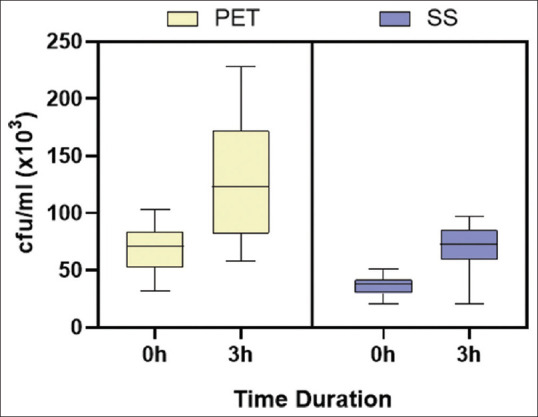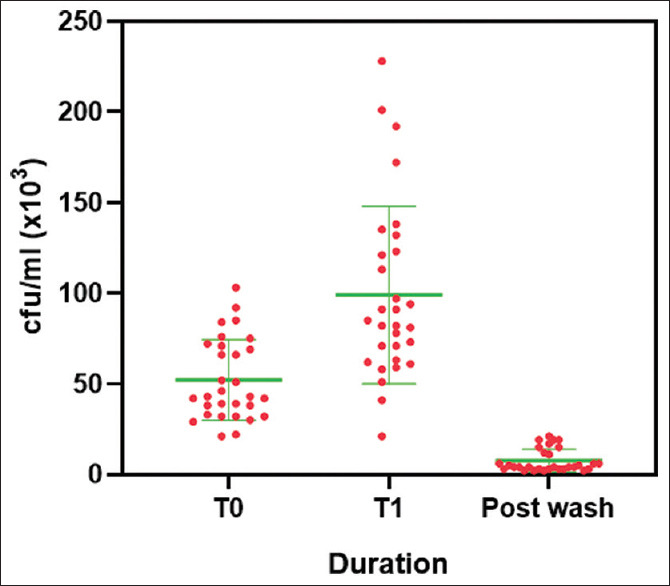ABSTRACT
Water bottles for everyday usage are a typical addition to people’s life and offer a practical way to stay hydrated. Even though safe and clean water is preferred for consumption, the water bottle or container used to drink water was never considered to be cleaned. Here, we examined the adhering microbial populations in water bottles composed of stainless steel (SS) and polyethylene terephthalate (PET). A total of 30 water bottles—15 PET and 15 SS—were gathered from different users. To identify and quantify the adhering microbial populations, microbial swabs from the inside surface of the bottles were collected and later cultivated on certain growth media. Overall the microbial load of PET is significantly higher than the SS water bottles of 68.8 + 19.1 cfu/ml and 35.4 + 8 cfu/ml respectively at initial sampling (P = 0.0027). We also evaluated the efficiency of various cleaning procedures in eliminating adherent bacteria populations. The cleaning strategy significantly reduced the microbial load (P<0.0001). The mean load observed was 11.2 + 2.3 cfu/ml post-wash. This comparison study offers important new information about the adherent microbial populations found in SS and PET water bottles used every day, in the end. This finding emphasizes the necessity of routine cleaning and upkeep of these bottles to reduce the possibility of microbial contamination and the accompanying health risks.
KEYWORDS: Clean water and sanitation, hygiene, microbes, potable water, sanitization, water bottles
INTRODUCTION
Water is a crucial resource for staying hydrated and preserving overall health. Reusable water bottle use has significantly increased in popularity as a result of rising health and environmental concerns. However, concerns regarding their cleanliness and safety are raised by the microbial communities that have grown on the inside surfaces of these bottles over time.[1] The transmission of these illnesses can occur during bathing, washing, drinking polluted water, or by consuming infected food. Globally, the availability of potable water is limited which requires sustainable resource management.[2,3] Since the quality of tap water is not recommended for direct consumption and best practices are used to sterilize the water.[4]
Ironically, people perceive bottled water as being clean and safe which is always true as they may be contaminated chemically or microbiologically.[5] Biological contaminants in water are predominantly bacteria, virus, protozoa, yeast, fungus, and their toxins are responsible for water-borne disease such as gastroenteritis.[6] The World Health Organization (WHO) recommends that potable water should have below 20 cfu/mL heterotrophic bacterial counts with no coliform bacteria, fecal coliforms, E. coli, Enterococci, and P. aeruginosa.[7,8] Water-related illnesses commonly spread through a community as a result of poor sanitation, lack of clean water supply, and poor hygiene. Protozoa, bacteria, and viruses are among the microbes that frequently transmit illnesses through water.
Many illnesses may be spread by germs or parasites that unintentionally, or sometimes as a result of extraordinary conditions, have entered the water (Pseudomonas, Mycobacteria, Giardia, and Cryptosporidium).[9] Microbes or parasites that unintentionally entered the water, maybe as a consequence of extraordinary conditions, could spread a variety of illnesses. Water bottle surfaces frequently experience microbial adhesion, which can result in the development of biofilm. Complex microbial colonies known as biofilms are encased in an extracellular matrix that they self-produce and cling to solid surfaces.
These bottles may provide health concerns to anyone utilizing them since they can serve as reservoirs for a variety of harmful bacteria, fungus, and other microbes. Contaminated water bottles pose a health risk in transmitting diseases among the users causing gastrointestinal illness, reproductive problems, and neurological disorders.[10,11]
Daily use personal water bottles are used frequently by individuals due to surge in various communicable diseases. Yet, a proper sanitization or cleaning of personal water bottles never gained attention. Hence, we aimed to investigate the microbial buildup on daily use water bottles and the risk factors associated with it. Also, we intended to assess the efficacy of an interventional washing step in the reduction of microbial load.
MATERIALS AND METHODS
Setting
The prospective study was performed with volunteers of first-year undergraduate medical students at Saveetha Medical College and Hospital, SIMATS, Saveetha University, Chennai, India. The participants were explained about the study and sampling procedures by obtaining informed consent.
Sampling
Thirty participants with PET (n = 15) and SS (n = 15) personal water bottles were selected from first-year medical graduate students. Using a sterile swab, the inside surface of each bottle was wiped, paying close attention to the inner walls, cap, and spout. This above procedure was performed at 0 h and 3 hr after the first sampling procedure. The swabs were transferred to a sterile test tube or container and sent for microbial culture.
Microbial investigator
The swab was dipped in sterile tryptone broth and spread onto Mueller–Hinton agar plate for bacterial growth. The plates were incubated at 37°C for 24 hours to observe microbial growth, and the colonies were enumerated as cfu/ml.
Data analysis
The CFU/ml was enumerated and entered into Microsoft Excel sheet. The mean and standard deviations were calculated for analysis. Data from returned questionnaires were analyzed with Statistical Package for Social Sciences (SPSS) v. 14.0 software. Data comparison was performed using the Student’s t-test, and the Chi-square test with P ≤ 0.05 was considered statistically significant.
RESULTS
A total of 30 samples, 15 each from SS and PET water bottles, were collected. The majority of users (n = 25, 83.3%) had their water bottles for more than six months. The typical supply of water comes from a home RO system (n = 28, 93.3%). It’s interesting that 22 (73%) people drink water by direct mouth contact. Among them 50% share their water bottles with others posing a potential threat of spread of microbes between the cohort. A total of 27 (90%) people regularly replenish the water available in the facility without washing or rinsing. It is also observed that there are differential washing periods from days to months of their personal water bottles and few (13%) were unaware of its cleansing.
Overall the microbial load of PET is significantly higher than the SS water bottles with CFU values of 68.8 ± 19.1 and 35.4 ± 8.2 respectively at initial sampling (P = 0.0027) [Figure 1]. Post 3 h usage of the water bottles, PET harbored a 70% increase of microbial load where it was 23% from SS bottles (P < 0.0001).
Figure 1.

Microbial load on PET Vs SS water bottles cfu: colony forming unit, SS: stainless steel.
To evaluate the influence of intermediate cleaning procedure on the microbial buildup, the samples tested revealed that washing reduced significantly (P < 0.0001) the microbial load as compared to 3 hrs. The mean load observed was 11.2 ± 2.3 cfu/ml post-wash [Figure 2].
Figure 2.

Microbial load at different time points and after intermediate wash cfu: colony forming unit. T₀: 0 hrs, T₁: 3 hrs
Water bottles with direct mouth contact had a microbial load of 234 ± 21.3 cfu/ml versus non-mouth contact was 132 ± 18 cfu/ml.
DISCUSSION
The microbial load in PET is relatively high when compared to SS. The result also shows that the microbial load is more in people drinking water from the bottle with direct mouth contact. Also, the sharing of these bottles with direct mouth contact causes water-borne diseases. As recent study suggests, regular use of reusable water bottles harbors more microbes than toilet seats.[12,13] We also found an increase in microbial growth in the water bottles over a period of time. There are no guidelines about intermediate cleaning or sterilization of reusable water bottles and how to tackle the microbial growth in them. Further study is needed to screen for the species among the water bottles in a large number of samples. Also studying the impact of intermediate cleaning or cleansing on water bottles on the microbial load is worth investigating.
This study contributes to the new knowledge by exploring the microbial load on the daily use personal drinking water bottles of PET and SS. We found SS bottles had less microbial load buildup as compared to PET bottles. Also, an intervention of the wash step reduces the microbial buildup. Further, by evaluating the adherence and survival rates of these microorganisms on hydrophobic glass surfaces, valuable insights can be gained regarding the potential benefits of such coatings in enhancing the hygienic properties of touch-enabled digital devices. Overall, this research has significant implications for public health and hygiene. Understanding the effectiveness of hydrophobic surfaces in reducing microbial populations on touch-enabled digital devices can inform the development of strategies to minimize the risk of infectious disease transmission in various settings, including healthcare facilities, educational institutions, and public spaces.
Investigating the microbiome of daily use water bottles and their drug-resistant pattern or pathogenic nature may provide a deep understanding of the risk factors involved in sharing water bottles. Since it is a pilot study, we couldn’t analyze large sample size and pathogen identification. We found that water bottle materials contribute a significant contribution to adherent microbial populations. PET bottles pose a major health risk on microbiological aspects. Also, the unawareness of water bottle hygiene also needs to be addressed.
Financial support and sponsorship
Nil.
Conflicts of interest
There are no conflicts of interest.
Acknowledgment
We thank the participants for the cooperation, support and providing details as per the questionnaire.
REFERENCES
- 1.Microbes in Pipes (MIP): The Microbiology of the Water Distribution System. Washington (DC): American Society for Microbiology; 2013. [PubMed] [Google Scholar]
- 2.Zamberlan da Silva ME, Santana RG, Guilhermetti M, Filho IC, Endo EH, Ueda-Nakamura T, et al. Comparison of the bacteriological quality of tap water and bottled mineral water. Int J Hyg Environ Health. 2008;211:504–9. doi: 10.1016/j.ijheh.2007.09.004. [DOI] [PubMed] [Google Scholar]
- 3.Armas AB, Sutherland JP. A survey of the microbiological quality of bottled water sold in the UK and changes occurring during storage. Int J Food Microbiol. 1999;48:59–65. doi: 10.1016/s0168-1605(99)00027-6. [DOI] [PubMed] [Google Scholar]
- 4.Bischofberger T, Cha SK, Schmitt R, König B, Schmidt-Lorenz W. The bacterial flora of non-carbonated, natural mineral water from the springs to reservoir and glass and plastic bottles. Int J Food Microbiol. 1990;11:51–71. doi: 10.1016/0168-1605(90)90039-8. [DOI] [PubMed] [Google Scholar]
- 5.Warburton D, Harrison B, Crawford C, Foster R, Fox C, Gour L, et al. A further review of the microbiological quality of bottled water sold in Canada: 1992-1997 survey results. Int J Food Microbiol. 1998;39:221–6. doi: 10.1016/s0168-1605(97)00135-9. [DOI] [PubMed] [Google Scholar]
- 6.Kohnen W, Teske-Keiser S, Meyer H-G, Loos AH, Pietsch M, Jansen B. Microbiological quality of carbonated drinking water produced with in-home carbonation systems. Int J Hyg Environ Health. 2005;208:415–23. doi: 10.1016/j.ijheh.2005.04.008. [DOI] [PubMed] [Google Scholar]
- 7.Reyes MI, Pérez CM, Negrón EL. Microbiological assessment of house and imported bottled water by comparison of bacterial endotoxin concentration, heterotrophic plate count, and fecal coliform count. P R Health Sci J. 2008;27:21–6. [PubMed] [Google Scholar]
- 8.Mohammadi Kouchesfahani M, Alimohammadi M, Nabizadeh Nodehi R, Aslani H, Rezaie S, Asadian S. Pseudomonas aeruginosa and heterotrophic bacteria count in bottled waters in Iran. Iran J Public Health. 2015;44:1514–9. [PMC free article] [PubMed] [Google Scholar]
- 9.Jeena MI, Deepa P, Mujeeb Rahiman KM, Shanthi RT, Hatha AAM. Risk assessment of heterotrophic bacteria from bottled drinking water sold in Indian markets. Int J Hyg Environ Health. 2006;209:191–6. doi: 10.1016/j.ijheh.2005.11.003. [DOI] [PubMed] [Google Scholar]
- 10.Ramírez-Castillo FY, Loera-Muro A, Jacques M, Garneau P, Avelar-González FJ, Harel J, et al. Waterborne pathogens: Detection methods and challenges. Pathogens. 2015;4:307–34. doi: 10.3390/pathogens4020307. [DOI] [PMC free article] [PubMed] [Google Scholar]
- 11.Leclerc H, Moreau A. Microbiological safety of natural mineral water. FEMS Microbiol Rev. 2002;26:207–22. doi: 10.1111/j.1574-6976.2002.tb00611.x. [DOI] [PubMed] [Google Scholar]
- 12.Bharath J, Mosodeen M, Motilal S, Sandy S, Sharma S, Tessaro T, et al. Microbial quality of domestic and imported brands of bottled water in Trinidad. Int J Food Microbiol. 2003;81:53–62. doi: 10.1016/s0168-1605(02)00193-9. [DOI] [PubMed] [Google Scholar]
- 13.Lal S, Ujan JA, Parkash O, Ghumro WA. Detection of bacterial contamination in dental unit water lines and testing the effectiveness of disinfectant against these contaminants: Bacterial contamination of Dental Unit Water Lines. Biol Sci PJSIR. 2022;65:260–8. [Google Scholar]


